In Round 23 of Serie A, the fans all around the globe were in for a treat as Milan took on Inter in the 228thDerby di Milano at the Stadio San Siro. The match was classed as a potential title decider, with both Milan clubs coming into the derby as the two top sides in the league for the first time since 2011.
Inter were one point ahead coming into Sunday’s clash, with Milan losing out on the top spot in the Serie A standings following a defeat to Spezia, after leading the way for 18 consecutive match-days.
The Nerazzurri were seen as slight favorites over Milan by the majority of football experts, and it proved to be the correct choice as Antonio Conte’s men crushed their fierce cross-city rivals 3-0 thanks to the goals from the deadliest striker partnership in Europe at the moment in Lautaro Martinez and Romelu Lukaku.
It was a statement win by Inter, which sees them go four points clear at the top of the Serie A table, while Milan have lost their fourth league game in 2021, with the Scudetto gradually slipping out of their hands.
The following tactical analysis will break down the key playing patterns of both teams, explaining the intricacies of their tactical approach to the game.
Starting Lineups and Formations

Both managers went for their tried and trusted tactical formations as outlined in the graphics, though in possession, the teams altered their shape depending on the circumstances. In detail, Stefano Pioli opted for a 4-2-3-1 tactical shape, whereas Conte stuck with a 3-5-2 set-up.
Starting with Milan, Pioli fielded a traditional back four consisting of Davide Calabria at right-back, Simon Kjaer and Alessio Romagnoli at the heart of the defense and Theo Hernandez at left-back. The latter was often given license to drive forward and play as a winger at times, with Calabria staying fixed to his right-back position and becoming more of a right-sided center-back, which meant Kjaer and Romagnoli also had to shift across to cover the whole length of the pitch.
In midfield, Milan played with a double pivot in Sandro Tonali and Franck Kessié, with the 20-year-old Italian often drifting to the right half-space to support the right side of attack, whilst the 24-year-old Ivorian predominantly occupied the holding role. As usual, Hakan Calhanoglu was deployed in a central attacking midfield role but also often dropped much deeper to support the first phase of build-up. Alexis Saelemaekers occupied a wide position on the right-wing, while Ante Rebic often drifted inside from the left and played as a second striker alongside Ibrahimovic, with Hernandez taking up the entire left flank.
In contrast, Inter went with a back three system, including Alessandro Bastoni (left center-back), Stefan de Vrij (center) and Milan Skriniar (right center-back). The latter was also often seen occupying the right-back position when Inter intended to play out from the back, with Handanovic acting as a middle center-back, while both de Vrij and Bastoni split wide. Consequently, the right wing-back Achraf Hakimi was allowed to push up and combine with Nicolò Barella, who occupied the right half-space.
Ivan Perisic was the other wing-back often left isolated on the left-flank, having Christian Eriksen in support who operated in the inside left channel, while Marcelo Brozovic was the most reserved of the three central midfielders. As usual, Lautaro Martinez and Romelu Lukaku formed Inter’s striker partnership upfront.

Inter’s Offensive Strategy: Right-Wing Play Involving Skriniar, Hakimi, Barella and Lukaku
This season, Inter are the perfect example that winning at the highest level is still possible despite placing less emphasis on the possession-based style of play. Under Conte, the Nerazzurri are renowned for their directness and attacking with pace, which combined with quality players upfront has made Inter an unstoppable machine.
The Nerazzurri are ranked first in the league for the most counter-attacks with 23, third for the most crosses per game (avg. 13.3), and second for the most crosses into the penalty area (avg. 3.09). Besides, Conte’s men complete the second-highest number of dead ball passes (set-pieces) that lead to a goal, averaging 0.26 per game, and have also scored the second-highest number of set-piece goals this season (9).
Conte’s famous 3-5-2 formation has been working almost flawlessly this Serie A season, with the most emphasis being placed on the wing-play and the swift counterattacks. It would be fair to say that without quality players, Inter’s rather pragmatic but incredibly effective style of play would not work anywhere near as well as it does now.
Against Milan, the Nerazzurri’s main plan was to exploit the opponents’ left-flank through the passing intricacies of the right-sided players, predominantly Barella and Hakimi. Both mentioned players possess an incredible ability to drive the ball forward in a direct and vertical manner, which accompanied by their intricate positional rotations made it nearly impossible to stop them.
Additionally, Conte also had a plan to use his goalkeeper, Samir Handanovic, as an additional player in the build-up process, which allowed one of Inter’s center-backs, Skriniar in this instance, to shift to the right-back position with Hakimi moving higher up the pitch. Finally, Lukaku was the one who also often moved to the right-wing channel and was responsible for holding the play up, as well as dragging Milan’s back line to that side which created space in the center of the pitch.
In the image below, we can see the fundamental tactical principle of Inter’s game plan against Milan. Here, both center-backs in Bastoni and de Vrij split wide, with Handanovic operating as the middle center-back in a back three system. Consequently, the actual right-sided center-back in Skriniar moves to the right-wing channel to occupy the right-back spot, thus allowing Hakimi (right wing-back) to push higher up the pitch, with Barella positioned nearby his teammate.
As we can see, Milan attempted to apply a man-oriented high-press to prevent Inter from playing out from the back; however, if executed correctly, the ball would reach the right side of the pitch where a triangle of Skriniar, Barella and Hakimi was present.

An almost identical example is illustrated below although, this time, Skriniar moved to the inner right space and operated more as a right-sided center-back, with Hakimi and Barella staying close to form a triangle. Inter’s numerical advantage in the first line of their build-up meant that there was always a spare man available.

With Hakimi being one of the best if not the best-attacking full-backs in the Serie A, Inter also had a plan to shift the play to the left side of the pitch, thus dragging over the majority of Milan players to that side as well, which created space on the right-wing channel for Hakimi to exploit.

In some instances, Inter did slightly alter their build-up approach, with de Vrij and Bastoni positioning themselves a bit closer to each other, meaning Skriniar had to tuck inside and occupy his original position as a right-sided center-back. For this reason, Hakimi was also often involved in the early phase of the build-up, which due to Milan’s attempt to press man-to-man meant that Hernandez had to step out, thus leaving Romagnoli isolated one-against-one with Lukaku. Additionally, Milan’s high defensive line was the perfect invitation for Inter to play a long ball in behind for Lukaku to chase.


In the following image, we can see that Inter’s triangle was flexible and involved player rotations when needed, with Skriniar moving into midfield, while Barella dropped back to orchestrate the build-up.

Although Milan used a man-oriented pressing system, as mentioned before, to prevent Inter from progressing their play further up the pitch, it often did them more harm than good, as most of Milan players were too slow to react to the movement of their opponents. The image below illustrates it perfectly.

In a set of images presented below, we can see once again how Inter were able to build their play from the back using a numerical advantage created on the right-wing channel. On this occasion, de Vrij and Bastoni both split very wide again, with Handanovic involved in the build-up play as a middle center-back. Due to Milan’s philosophy to press their opponents in a man-oriented manner, Inter were able to create a spare man situation in the second phase of the build-up when the ball reached the midfield part of the pitch. As we can see, Rebic steps out to press Skriniar, which leaves Barella and Hakimi in space on the right side of the midfield area.

After progressing the ball through the first and second phases, Lukaku was often used as a target man who would hold the ball up, thus creating time and space for Hakimi and Barella to take up good positions for further transitioning. Additionally, a combination of Inter’s intent to play out from their own goal and Milan’s man-oriented high press meant that the Rossoneri had to defend with a high line, leaving space in behind.


Inter’s second goal of the game was a result of a less structured principle outlined above. The emphasis once again was placed on the right-sided wing-play, with Lukaku holding the ball up. The right side overload meant that Perisic was left isolated on the far left side with acres of space to run to, which eventually resulted in the Croatian getting an assist for Martinez’s second goal.


Inter’s preference to build their play down the right-wing channel is illustrated in the touch map image below.

Milan’s Attacking Organization: Ineffective Slow Possession and Little Creativity in the Final-Third
Milan are no longer leading the title race, as their form has significantly dropped following the turn of the year. The Rossoneri have lost for the second time in a row in Serie A, which also was their fourth domestic defeat in 2021. It is a clear indication that Milan are no longer wearing the invincibility crown, with some of their key performance indicators having seen a drop-off, which goes in line with what we have been witnessing on the pitch.
The Rossoneri have slipped down to the fifth place for goals scored (39) and shots per game (14.5), with only 4.96 of them hitting the target (6th place). Until the new year, Milan’s efficiency in front of goal was one of their standout attributes among the top teams in the Serie A; however, in the last weeks, Pioli’s men have been less effective in finding the back of the net and have slipped down the pecking order. On average, Milan need 7.6 shots to score a goal, whereas Inter (6.5), Roma and Atalanta (both 7.0) have sharpened their shooting boots in front of the goal.
Nonetheless, the most worrying sign in yesterday’s game was Milan’s inability to produce goal-creating actions. The Rossoneri failed to create a single goal-scoring action against Inter when on average, they have been creating 3.22 goal actions in Serie A this season, which is also only the sixth result in the league.
The main reason for that was Milan’s inability to get the ball into promising attacking areas in and around the box, as Inter’s solid 5-3-2 defensive block with a back line of five was hardly moved. The Rossoneri tried two tactics: 1) To build their play through the flank of Hernandez 2) If unsuccessful, switch the ball to the right side and overload it, which would consequently create space on the left side of the pitch.
Sadly for Milan and their fans, none of that worked against Inter. As we can see in the first image below, Rebic occupied a more central role next to Ibrahimovic to have more bodies up against Inter’s back three, thus preventing any of the three center-backs from leaving their position. As a result, Hernandez often found himself isolated one-on-one with Hakimi, while Calabria, Kjaer and Romagnoli formed a back three in possession.
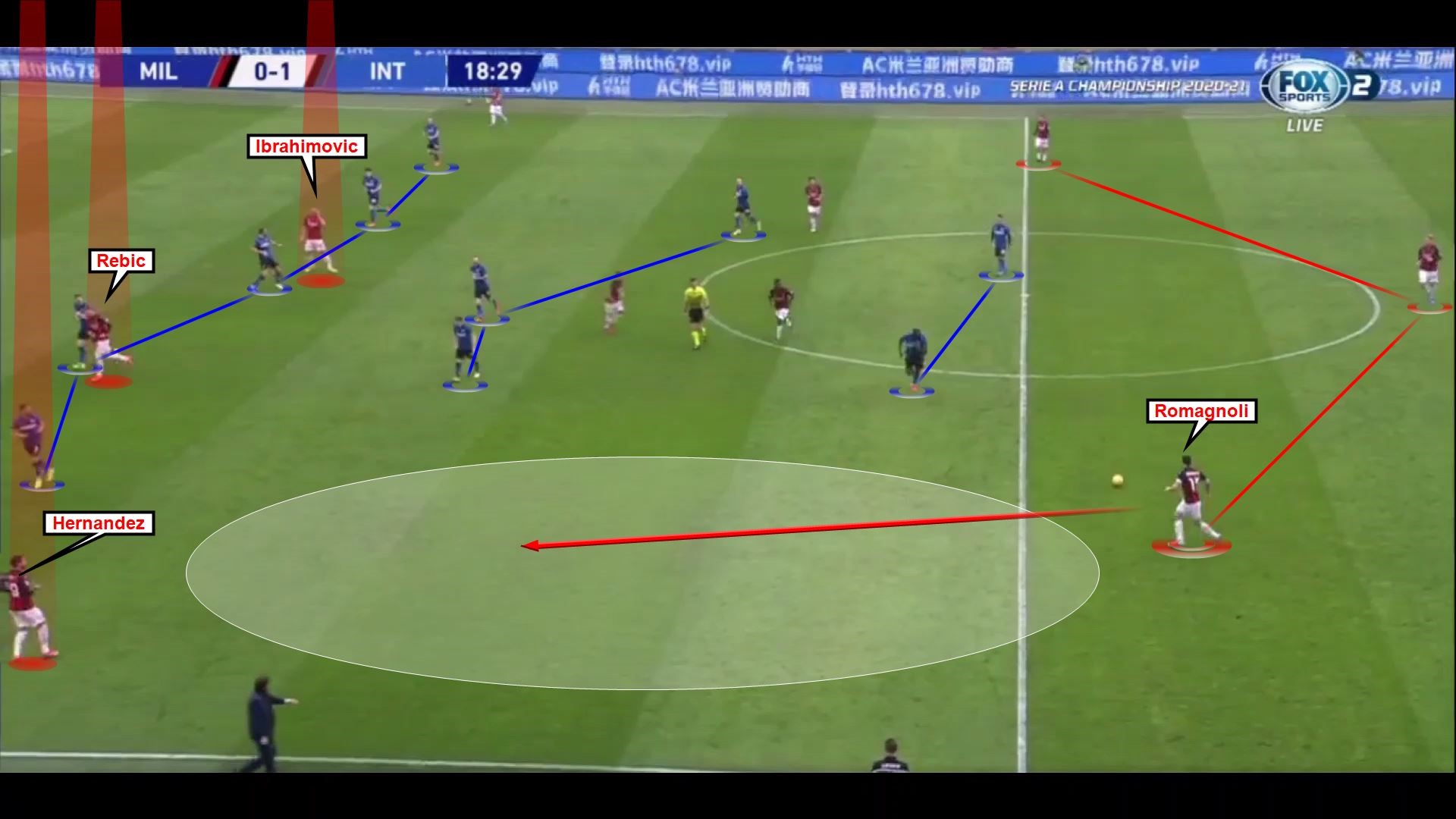
A similar situation can be observed below, as Romagnoli plays a pass to Hernandez, who this time collects the ball deeper. It forces Hakimi to step out of the back line and close down Milan’s left full-back. Additionally, we can see how Rebic and Ibrahimovic pin Inter’s back line, thus preventing them from shifting across to cover the vacated space. Nonetheless, such tactics did not prove to be successful, as Hernandez rarely attempted to beat Hakimi one-on-one.
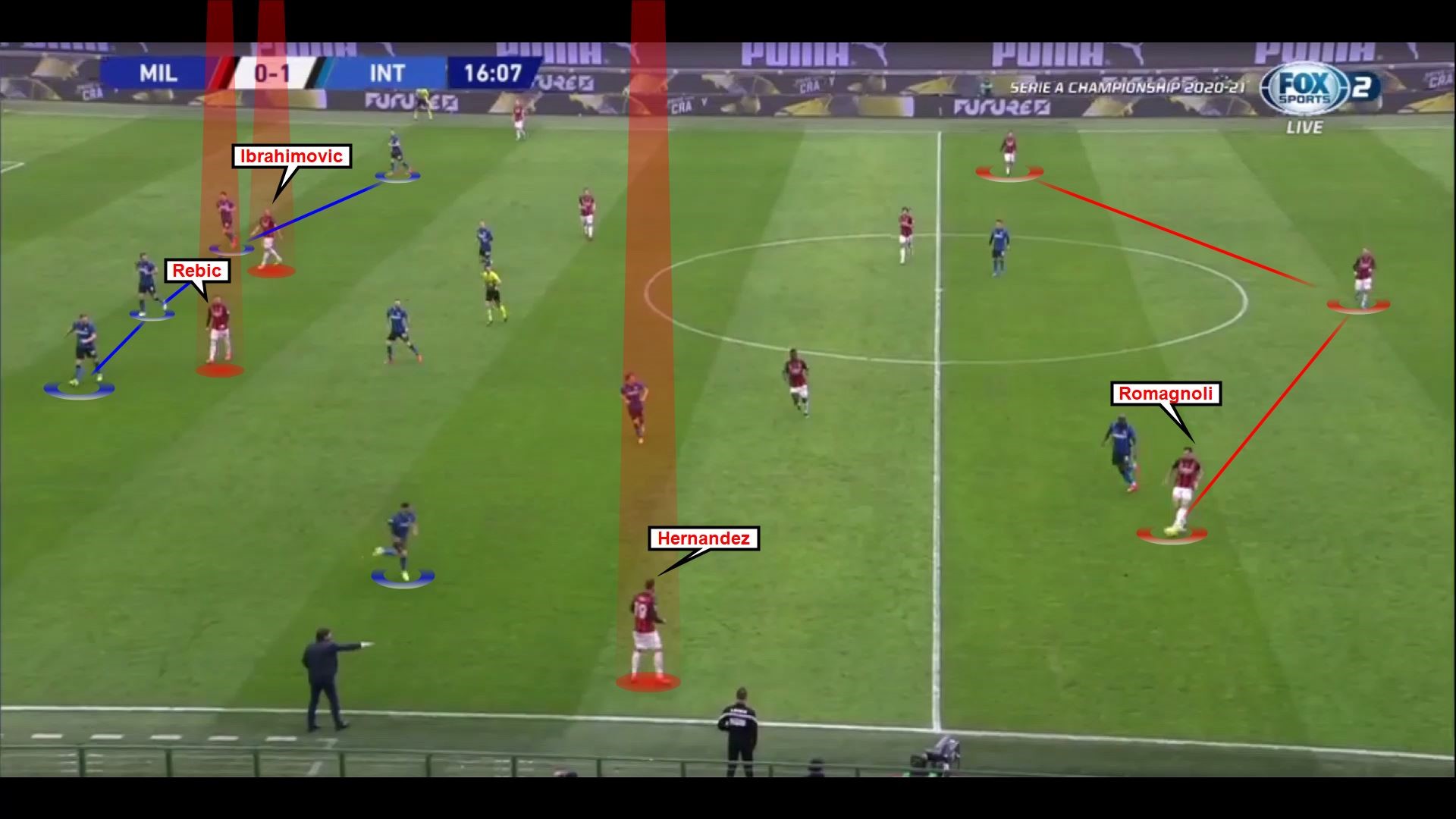
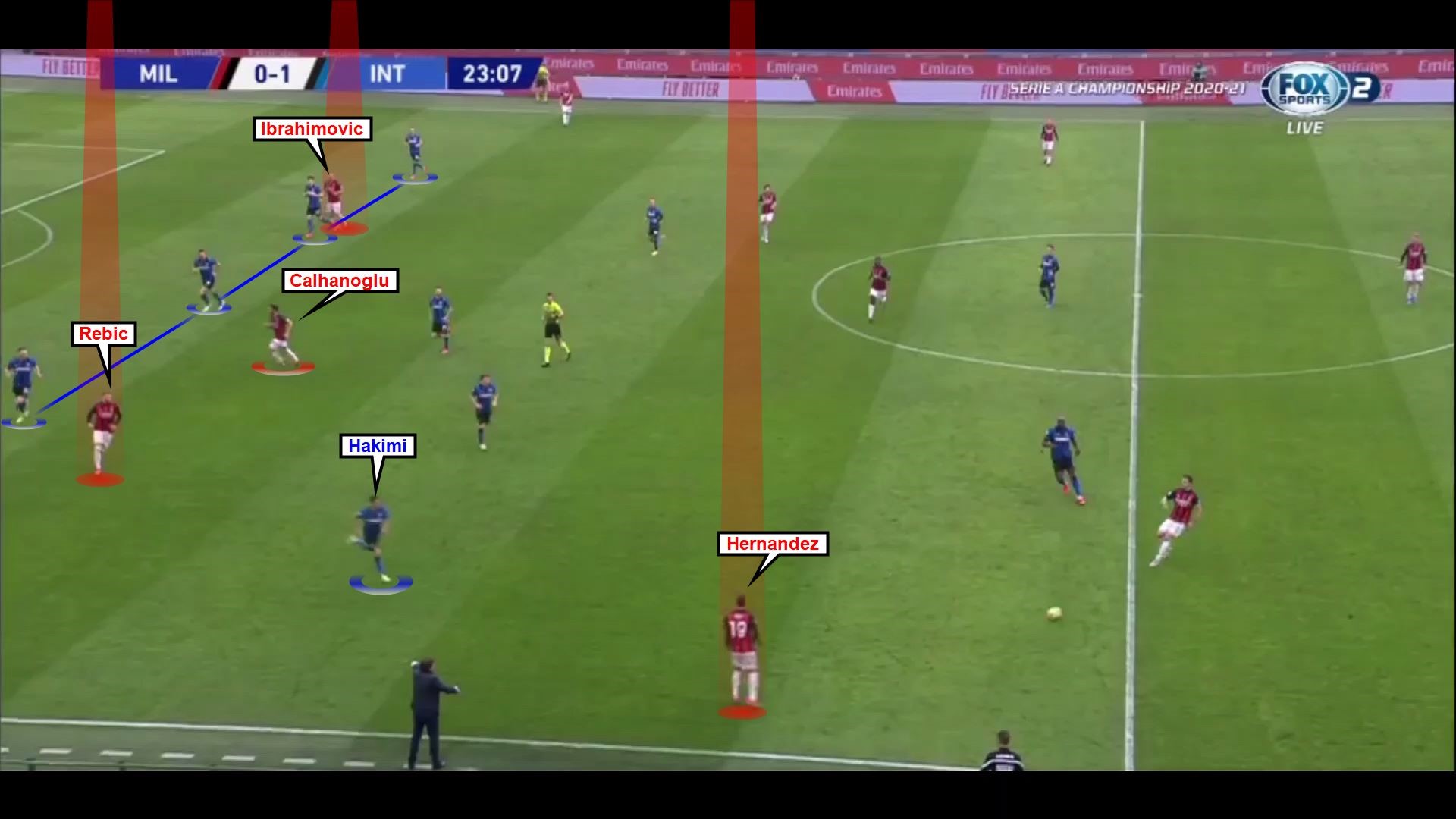
When Milan were unable to progress the ball down the left-wing through Hernandez, they often switched the play to the opposite side, where the Rossoneri used the principle of overload to isolate. As we can see in the image below, five Milan players are within close proximity to each other, thus pulling the majority of Inter players to the ball side as well. Consequently, it left Milan with two options of either moving the ball through the overloaded side and then play a pass into the feet of either Ibrahimovic or Rebic, or switch the play to the underloaded side of Hernandez.
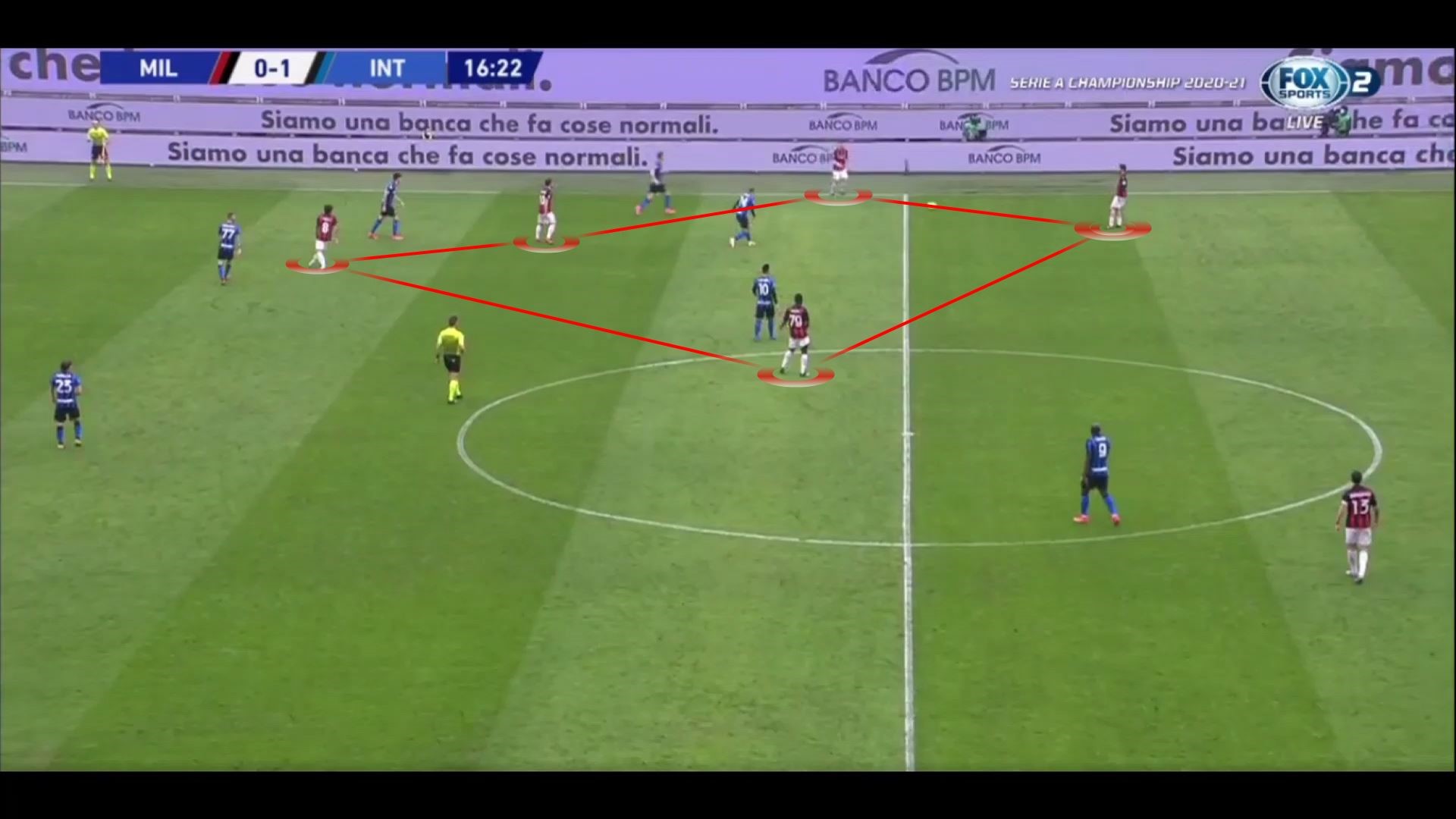

In most instances, Milan went for the second option; however, their switch of play was often too slow and by the time the ball was delivered to the left-wing, Hakimi was already glued to Hernandez, with solid support from the midfield line.


Overall, Milan lacked both ideas and intent in the final third of the pitch, as a player on the ball was often left stuck with no available passing options ahead of him. Against Inter, Milan played 36 crosses into the penalty box, in comparison to the Nerazzurri’s 14, and only 6 of those reached the targeted player (17% accuracy).


Shot Map of Both Teams
xG (expected goals): Milan 0.81 – 2.35 Inter
Result: Milan 0-3 Inter

Conclusion
Inter placed an ominous marker against their fierce cross-city rivals and Scudetto contenders Milan. It was a comprehensive and a truly deserved win for Conte’s men, who are now in the driving seat to clinch their first Serie A title since 2010. On the other hand, Milan’s overperformance was already evident a few months ago but back then, the Rossoneri were still able to come away with important points despite being second-best on the pitch. Although there are still 15 games left in this Serie A season, the title looks to be heading to the blue and black side of Milan.

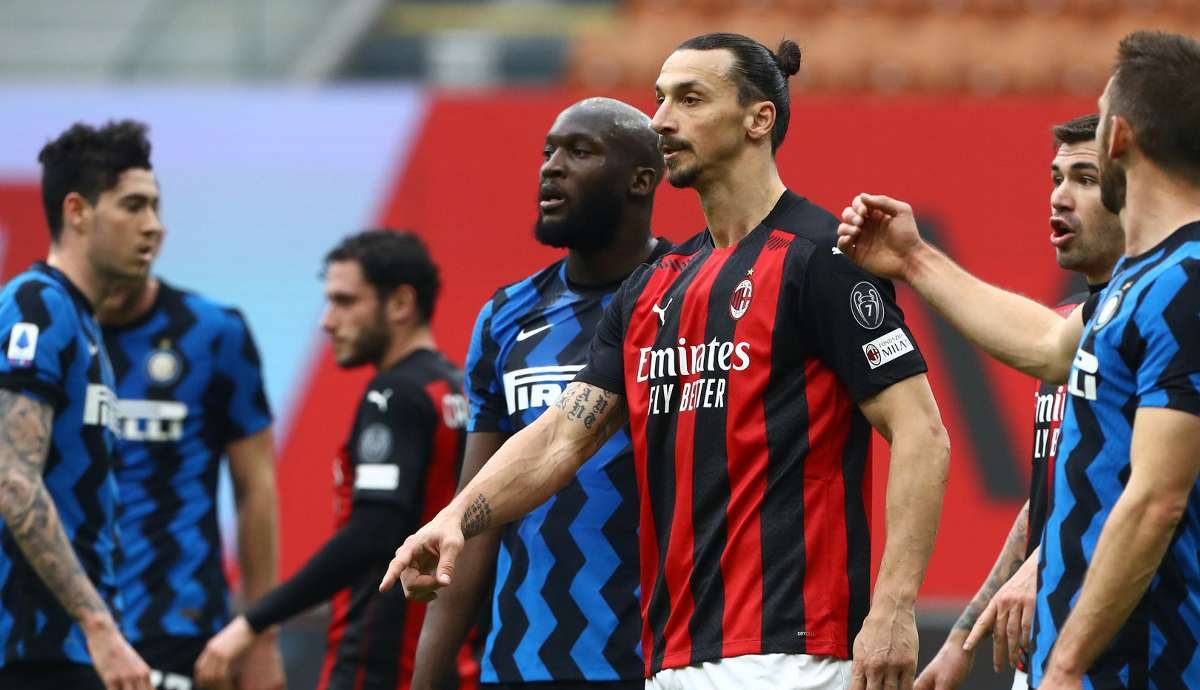
One comment
Comments are closed.